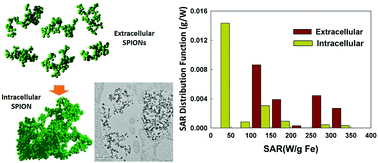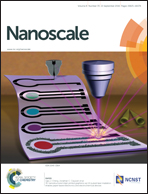Quantifying intra- and extracellular aggregation of iron oxide nanoparticles and its influence on specific absorption rate†
Abstract
A promising route to cancer treatment is hyperthermia, facilitated by superparamagnetic iron oxide nanoparticles (SPIONs). After exposure to an alternating external magnetic field, SPIONs generate heat, quantified by their specific absorption rate (SAR, in W g−1 Fe). However, without surface functionalization, commercially available, high SAR SPIONs (EMG 308, Ferrotec, USA) aggregate in aqueous suspensions; this has been shown to reduce SAR. Further reduction in SAR has been observed for SPIONs in suspensions containing cells, but the origin of this further reduction has not been made clear. Here, we use image analysis methods to quantify the structures of SPION aggregates in the extra- and intracellular milieu of LNCaP cell suspensions. We couple image characterization with nanoparticle tracking analysis and SAR measurements of SPION aggregates in cell-free suspensions, to better quantify the influence of cellular uptake on SPION aggregates and ultimately its influence on SAR. We find that in both the intra- and extracellular milieu, SPION aggregates are well-described by a quasifractal model, with most aggregates having fractal dimensions in the 1.6–2.2 range. Intracellular aggregates are found to be significantly larger than extracellular aggregates and are commonly composed of more than 103 primary SPION particles (hence they are “superaggregates”). By using high salt concentrations to generate such superaggregates and measuring the SAR of suspensions, we confirm that it is the formation of superaggregates in the intracellular milieu that negatively impacts SAR, reducing it from above 200 W g−1 Fe for aggregates composed of fewer than 50 primary particles to below 50 W g−1 for superaggregates. While the underlying physical mechanism by which aggregation leads to reduction in SAR remains to be determined, the methods developed in this study provide insight into how cellular uptake influences the extent of SPION aggregation, and enable estimation of the reduction of SAR brought about via uptake induced aggregation.



 Please wait while we load your content...
Please wait while we load your content...